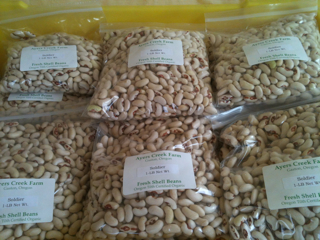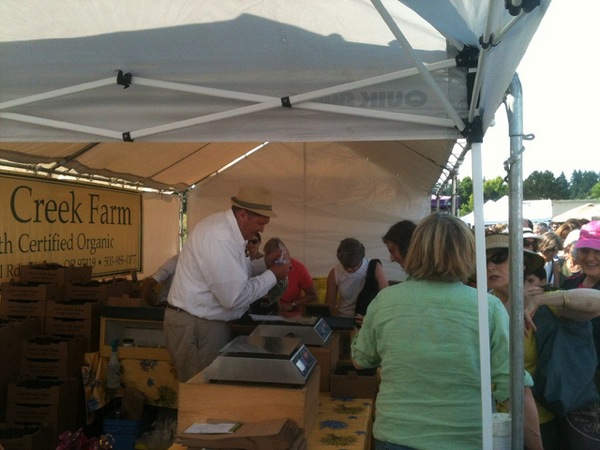Ayers Creek Farm Newsletter September 30 2012 Market
Guest User
 This Sunday marks the last day of September and the our last market of the season. Near enough to 10:00 AM, some stimulus, usually a bell but sometimes the nod of Eamon's head, will open the market.
This Sunday marks the last day of September and the our last market of the season. Near enough to 10:00 AM, some stimulus, usually a bell but sometimes the nod of Eamon's head, will open the market.
We will return to Hillsdale Farmers' Market on the 18th of November and linger through 17th of February. Chef and friend Cathy Whims once chided us for being a seven month farm. We stand accused, but in our defense we will add we that we do not stop farming, we just need the other months to assure a well-run farm. As we survey the crops for the winter markets, we are looking forward to our return.
This Sunday, Anthony will be selling his book, Beautiful Corn(link), and Carol's sister will help behind the scales. So you will have his full and undivided attention he will be placed some distance from the stall, something that is impossible under normal market conditions. For the holiday market, we are thinking about putting together a gift box with the book and other sundries to be determined.
At 11:00 AM, Hillsdale's market chef, Kathryn LaSusa Yeomans, will start preparing several dishes using hominy prepared from Amish Butter popcorn and Roy's Calais Flint corn. Both types will be available when we return to the market at the end of November. Especially if you harbor a chip on your shoulder about hominy and are not yet willing to prepare it yourself, stay a while and see how good the fresh version is. As Carol so often says, it will knock your socks off. We are looking forward to seeing what magic Chef Yeomans lends to this wonderful food.
Here is what we expect to bring:
Again, we will have an abundant supply of Astiana, our culinary tomato. As we did for the last two weeks, we will have some boxes, tape and a scale next to the tomatoes for bulk purchases. There will be some Striped German tomatoes as well.
We hope to have some plums and onions.
In addition, almost all of our dry beans have been harvested and we will bring is a broad selection this Sunday, along with chickpeas. The beans will include Tarbais, Borlotto Lamon, Dutch Bullet, Black Turtle, Zolfino and Purgatorio.
We will also have some preserves. Our selection is very limited but good on toast, cheese or paté. One of our tasks over the next two months will be our annual three day pilgrimage to Sweet Creek Foods to make our preserves. We will be adding jostaberry to the mix of preserves. Our selection up plum preserves will be robust, joined by gooseberry again.
An Agricultural Act
For those who love our Astiana tomatoes, flint corn and popcorn, the beans and all of those wonderful chicories, imagine how good life would be if we and other quality market farmers were allowed to lavish the same attention on Cannabis sativa. The plants would be organically grown in the field with dilute foliar sprays of salt and kelp, followed with timely and careful harvest and cleaning. Levity aside, Measure 80, the Oregon Cannabis Tax Act, is one more proposal for relieving this nation of it crazy fixation on marijuana. The prohibition clogs the court system and destroys peoples' lives senselessly. More importantly, Measure 80 is an agricultural act.
This Friday, for the better part of three hours, seed growers and fresh vegetable farmers testified against recklessly changing Oregon Department of Agriculture's quarantine in rapeseed, aka canola, in the Willamette Valley. It is a known noxious weed which will increase disease and insect pressure, and cross pollinate with valuable seed crops. In a surrealistic procedure, we testified before a hearings officer, an impassive scribe, who had no decision-making authority and no working knowledge of the issue. Our testimony was delivered in three minute snippets, governed by horizontal traffic light. For those who recall Woody Allen's Sleeper, it was a scene reminiscent of talking to the leader's nose. Using a hearings officer in this manner is simply agency cowardice and insouciance; dozens of farmers joined by numerous other citizens took the time to express their concerns and the agency's decision-makers hid behind the "nose" with no interest in engaging the public. We were an inconvenient step towards a decision they have already made.
It doesn't have to be this way. When Janet McClennan and Dick Roy, both of whom frequent the Hillsdale Farmers' Market, were members of the Board of Forestry, they sat through hours of public testimony regarding forest practices and other thorny issues with Jim Brown, the state forester. Chair McClennan, and her predecessor Tom Walsh, took the time to thank each person when their testimony concluded. The board members and state forester engaged people appearing before them with respectful questions when appropriate. Their discussion following the testimony took place in public, and took into account the testimony. They followed a consent agenda, so if no member of the board dissented that agenda item was approved. It was a glowing example of public process and civil engagement, in the finest spirit of democracy. Unfortunately, the Department of Agriculture chose the exactly opposite route, leaving us to speak to an impassive nose and then finalizing the decision behind closed doors. It was a shabby example of public process and civil engagement, with nary a shadow of democratic spirit.
This bring us back to Measure 80. Currently, the domestic production of hemp is impossible because of its relationship to marijuana. Hemp is a valuable, high quality fiber and oilseed plant that is well adapted to the climate of Oregon. Disentangling ourselves for our state and national marijuana prohibition, will allow the cultivation of Cannabis sativa for its fiber and oil, as a well a pharmaceutical. If it is joined by the passage of similar laws in Washington and Colorado, its will be big step in opening the conversation about legalizing its cultivation nationally. Is Measure 80 perfect, probably not as the Oregonian has taken pains to point out, no law is upon passage. But a statutory measure can be amended easily. So, as we fill in our ballot sometime in October, these two farmers will mark "yes" on Measure 80 as an agricultural act.
And if we miss you Sunday, we hope to see you on the 18th of November, santé,
Carol and Anthony Boutard
Ayers Creek Farm







 This spell of hot weather should be a mere memory by the time we finish hauling the flats of berries out of the van at Hillsdale. It has tested our mettle. You will hear the tintinnabulation of the bovine necklace around 10:00 AM.
This spell of hot weather should be a mere memory by the time we finish hauling the flats of berries out of the van at Hillsdale. It has tested our mettle. You will hear the tintinnabulation of the bovine necklace around 10:00 AM.